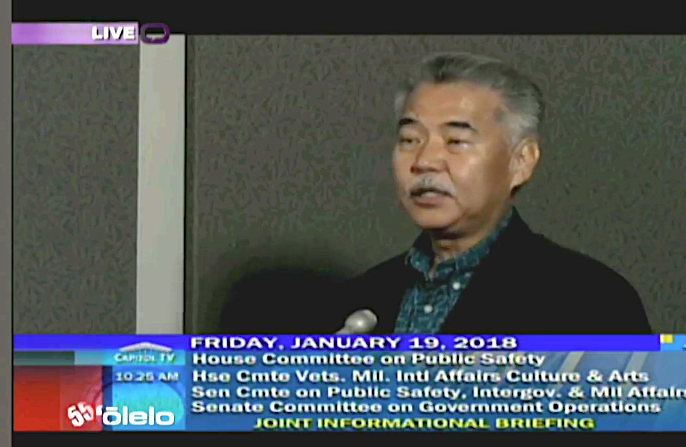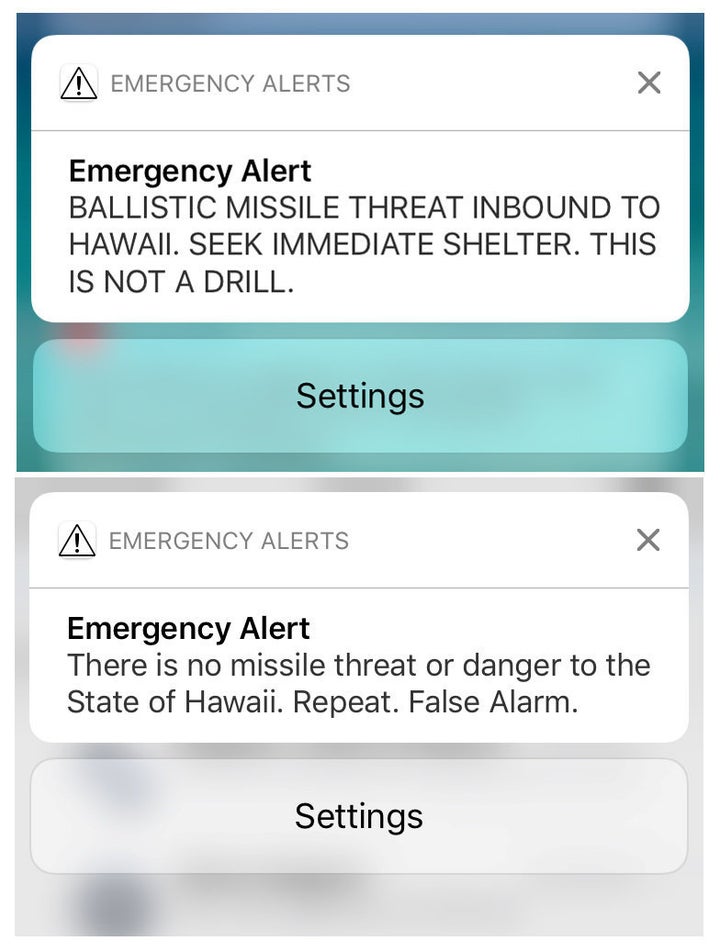
A hearing with Hawaii lawmakers on Friday revealed that Gov. David Ige knew last weekend’s missile alert was a false alarm two minutes after it was broadcast across the state, but didn’t notify the public of it until 15 minutes later.
The false alert was triggered at 8:07 a.m. on Jan. 13. Maj. Gen. Arthur “Joe” Logan told state legislators that he personally called Ige to let him know that Hawaii was not facing a missile threat at 8:09 a.m.
It wasn’t until 8:24 a.m. that the governor’s office publicly acknowledged the mistake by retweeting the Hawaii Emergency Management Agency, with the added note, “There is NO missile threat.”
Six minutes after that, a note about the false alert appeared on Ige’s Facebook page.
“I don’t know what the governor was doing. I wasn’t with him at the time,” Logan told lawmakers. “I know he was preparing to go to an event and this circumvented all of that.”
While this new detail prompted state lawmakers to ask more questions about that particular lapse of time, Ige wasn’t able to respond. The governor left 45 minutes into the two-hour hearing.
Ige’s spokeswoman Cindy McMillan told HuffPost that the governor didn’t alert the public right away because his staff handles his social media accounts. “It took time for the governor to contact us and give us the information before we could post it,” she said.
McMillan didn’t answer HuffPost’s question asking why Ige couldn’t publish the message himself.

People in Hawaii were in a state of panic and confusion last weekend after a state emergency employee accidentally triggered an incoming missile alert to cellphones, TV and radio broadcasts during a routine drill.
While officials called radio stations and news stations and issued corrections on social media, it took 38 minutes for the Hawaii Emergency Management Agency to broadcast a correction using the same alert system.
An official with Honolulu Emergency Medical Services said 911 calls briefly spiked in the hour after the statewide alert. At least one person, a 51-year-old man, suffered a heart attack as a result of the alarm and was transported to the hospital in critical condition, an EMS official told HuffPost.
The first person to notify the public of the emergency agency’s mistake appears to be a 17-year-old who was able to call state emergency officials immediately after receiving the alert.
The high school student, William Heyler, told local news station KHON2 that he decided to check in with the agency after he noticed that there were no sirens to accompany the alarm. Within five minutes of the alert, Heyler talked to an official and tweeted that it was a mistake.
His tweet went out at 8:12 a.m.
At 8:19 a.m., Rep. Tulsi Gabbard (D-Hawaii) became the first state official to acknowledge the mistake when she tweeted that she’d confirmed there was no missile headed to Hawaii.
After Ige left Friday’s hearing, Democratic state Rep. Kaniela Ing told emergency officials that he was disappointed that the governor had slipped out early.
“I can’t imagine what’s more important than this right now,” Ing said.
McMillan told HuffPost that the governor had to leave the hearing early to attend to other appointments he couldn’t reschedule on Friday afternoon.
During Friday’s hearing, lawmakers probed emergency officials about the mistake and urged them to address the flaws in the response to last weekend’s botched drill.
One lawmaker blamed the Hawaii Emergency Management Agency’s entire system for the prolonged panic.
“It wasn’t just the fault of one man in a room pushing a button,” Democratic state Rep. Matt LoPresti said on Friday. “It was the entire system.”
Lt. Col. Charles Anthony, a spokesman for the Hawaii Department of Defense, told HuffPost on Thursday that it took more than 30 minutes to send a follow-up alert because their system did not have a feature that allowed employees to send follow-up alerts after one is already sent.
After last week’s mishap, the emergency agency has added a cancellation feature that would allow officials to correct any false alerts almost immediately. Additionally, the agency requires two people to sign off on alerts before one is broadcast to the state.
National Guard Brig. Gen. Kenneth Hara is conducting a thorough review of the false alert and will provide state officials with an action plan on how to improve the state’s missile preparedness and alert system in the coming months.
